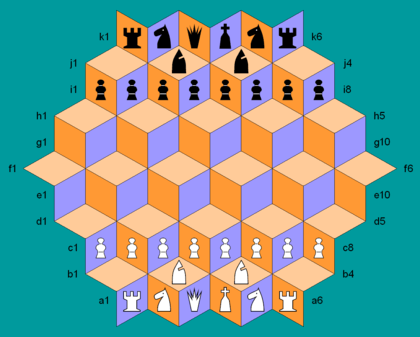Rhombic chess
Rhombic chess is a chess variant for two players created by Tony Paletta in 1980.[1][2] The gameboard has an overall hexagonal shape and comprises 72 rhombi in three alternating colors. Each player commands a full set of standard chess pieces.

The game was first published in Chess Spectrum Newsletter 2 by the inventor. It was included in World Game Review No. 10 edited by Michael Keller.[3]
Game rules
The diagram shows the starting setup. As in standard chess, White moves first and checkmate wins the game. Piece moves are described using two basic types of movement:
- Edgewise—through the common side of adjoining cells. If an edgewise move is more than one step, it continues in a straight line from the side of a cell through its opposite side, the line being orthogonal to these sides.
- Pointwise—through the sharpest corner of a cell, in a straight line to the next cell. (The paths are highlighted on the board by same-colored cells.)
Piece moves
- A rook moves edgewise only.
- A bishop moves pointwise. It can also move one step edgewise.[lower-alpha 1]
- The queen moves as a rook and bishop.
- The king moves one step edgewise or pointwise. There is no castling in rhombic chess.
- A knight moves in the pattern: one step edgewise followed by one step pointwise (or vice versa), away from its starting cell. Like a standard chess knight, it leaps any intervening men.[2]
- A pawn moves forward one step edgewise, with the option of two steps on its first move. A pawn captures the same as it moves. There is no en passant in rhombic chess. A pawn promotes to any piece other than king when reaching rank i (for White) and rank c (for Black).[lower-alpha 2]
Parachess

Circa 2000, Paletta created Parachess[lower-alpha 3] using the same board geometry but introducing additional ways to move:
- An arcwise step—through the sharpest corner of a cell, to a cell not connected to the starting cell edgewise or pointwise.
- A wavepath move—a series of arcwise steps, with each step in the opposite direction of the preceding step.
These ways to move are highlighted on the board by same-colored cells.
Piece moves
- A rook moves edgewise only (as in rhombic chess).
- A bishop moves pointwise (as in rhombic chess) or along a wavepath.
- The queen moves as a rook and bishop.
- The king moves one step edgewise, pointwise, or arcwise. As in rhombic chess, there is no castling.
- The sorcerer moves in the pattern: one step pointwise, followed by one step edgewise or arcwise, or vice versa. It leaps any intervening men.
- A pawn moves forward one step edgewise, pointwise, or arcwise; there is no initial two-step option. A pawn captures forward one step edgewise or pointwise. There is no en passant. A pawn must reach the opponent's furthest rank in order to promote.
Notes
References
- Pritchard (1994), p. 255
- Pritchard (2007), p. 214
- Keller, Michael, ed. (June 1991). "A Panorama of Chess Variants". World Game Review. No. 10. Michael Keller. ISSN 1041-0546.
Bibliography
- Pritchard, D. B. (1994). The Encyclopedia of Chess Variants. Games & Puzzles Publications. ISBN 0-9524142-0-1.CS1 maint: ref=harv (link)
- Pritchard, D. B. (2007). Beasley, John (ed.). The Classified Encyclopedia of Chess Variants. John Beasley. ISBN 978-0-9555168-0-1.
External links
- Parachess by Tony Paletta, The Chess Variant Pages